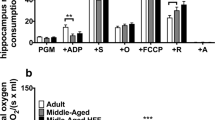Abstract
Reducing dietary intake has been shown to be the most effective means for modulating aging processes in laboratory rodents. Dietary restriction has also been shown to be a modulator of membrane lipid peroxidation and cytosolic antioxidant status. In the present study, anti-radical action of dietary restriction was investigated further by quantitating the formation of the superoxide radical, hy- droxyl radical and hydrogen peroxide by liver microsomes from rats of various ages. The results show that the ad libitum fed group maintained a higher production of superoxide and hydroxyl radicals when compared to the food restricted group of the same age. Hydrogen peroxide formation followed the same trend but was statistically greater only at 3 and 6 months of age. The food restricted group tended to show a higher superoxide dismutase (SOD) activity in both cytosolic and mitochondrial fractions than ad libitum fed controls. These data indicate that the free radical activity observed in the liver microsomes of ad libitum fed rats can be attenuated by dietary restriction, thereby providing a possible biochemical mechanism for its anti- lipoxidative action on membrane lipid peroxidation as reported in an earlier study. This action may in part underlie the life span- prolonging action of food restriction. (Aging 2:357–362,1990)
Similar content being viewed by others
References
Harman D.: The aging process. Proc. Natl. Acad. Sci. USA 78: 7124–7128,1981.
Pryor W.A.: Free radicals in antioxidation and in aging. In: Armstrong D., Sohal R.S., Cutler R.G., Slater T.F. (Eds.), Free Radicals in Molecular Biology, Aging, and Disease. Raven Press, New York, 1984, pp. 13–41.
Halliwell B., Gutteridge M.C.: Oxygen toxicity, oxygen radical, transition metals and disease. Biochem. J. 219: 1–14, 1984.
Slater T.F.: Free radical mechanism in tissue injury. Biochem. J. 222: 1–15, 1984.
Sawada M., Carlson J.C.: Changes in superoxide radical and lipid peroxide formation in the brain, heart and liver during the lifetime of the rat. Mech. Ageing Dev. 41: 125–138, 1987.
Nohl H., Hegner D.: Do mitochondria produce oxygen radicals in vivo? Eur. J. Biochem. 82: 563–567, 1978.
Cand F., Verdetti J.: Superoxide dismutase, glutathione peroxidase, catalase, and lipid peroxidation in the major organs of the aging rats. Free Radic. Biol. Med. 7: 59–63,1989.
Yu B.P., Lee D.W., Marler C.G., Choi J.H.: Mechanism of food restriction: Protection of cellular homeostasis. Proc. Soc. Exp. Biol. Med. 193: 13–15, 1990.
Chipalkatti S., Ajit K., Anant D., Aiyar S.: Effect of diet restriction on some biochemical parameters related to aging in mice. J. Nutr. 113: 944–950, 1983.
Koizumi A., Weindruch R., Walford R.L.: Influences of dietary restriction and age on liver enzyme activities and lipid peroxidation in mice. J. Nutr. 117: 361–367, 1987.
Chen L.H., Lowry S.R.: Cellular antioxidant defense system. In: Snyder D.L. (Ed.), Dietary Restriction and Aging. Alan R. Liss, Inc., New York, 1989, pp. 247–256.
Semsei L., Rao G., Richardson A.: Changes in the expression of superoxide dismutase and catalase as a function of age and dietary restriction. Biochem. Biophys. Res. Commun. 164: 620–625,1989.
Yu B.P., Masoro E.J., McMahan C.A.: Nutritional influences on aging of Fischer-344 rats. I. Physical, metabolic, and longevity characteristics. J. Gerontol. 40: 657–770, 1985.
Laganiere S., Yu B.P.: Anti-lipoperoxidation action of food restriction. Biochem. Biophys. Res. Commun. 145: 1185–1191, 1987.
O’Brien P.J.: Superoxide production by rat liver microsomes using partially succinoylated cytochrome c. In: Packer L. (Ed.), Methods in Enzymology. Academic Press, New York, 1984, Vol. 105, pp. 375–376.
Kuthan H., Ullrich V.: A quantitative test for superoxide radicals produced in biological systems. Bio-chem. J. 203: 551–558, 1982.
Halliwell B., Grootveld M., Gutteridge J.M.C.: Methods for the measurement of hydroxyl radicals in biochemical systems: Deoxyribose degradation and aromatic hydrbxylation. In: Glick D. (Ed.), Methods of Biochemcal Analysis. John Wiley & Sons, New York, 1988, Vol. 33, pp. 59–90.
Thurman R.G., Ley H.G., Scholz R.: Hepatic microsomal ethanol oxidation. Eur. J. Biochem. 25: 420- 430,1972.
McCord J.M., Fridovich I.: Superoxide dismutase: An enzymatic function for erythrocuprein (hemocu- prein). J. Biol. Chem. 244: 6049–6055, 1969.
Lowry O.H., Rosenbrough N.J., Farr L.A., Randall R.S.: Protein measurement with the Folin phenol reagent. J. Biol. Chem. 193: 265–275, 1951.
Laganiere S., Yu B.P.: Effect of chronic food restriction in aging rats. 1. Liver subcellular membranes. Mech. Ageing Dev. 48: 207–219, 1989.
Laganiere S., Yu B.P.: Effect of chronic food restriction in aging rats. II. Liver cytosolic antioxidants and related enzymes. Mech. Ageing Dev. 48: 221–230, 1989.
Floyd R.A., Zaleska M.M., Harmon H.J.: Possible involvement of iron and oxygen free radicals in aspects of aging in brain. In: Armstrong D., Sohal R., Cutler R.G., Slater T.E. (Eds.), Free Radicals in Molecular Biology, Aging, and Disease. Raven Press, New York, 1984, pp. 143–161.
Mehlhorn R.J., Cole G.: The free radical theory of aging: A critical review. In: Pryor W.A. (Ed.), Advances in Free Radical Biology and Medicine. Pergamon Press, New York, 1985, pp. 165–223.
Cutler R.G.: Antioxidants, aging, and longevity. In: Pryor W.A. (Ed.), Free Radicals in Biology. Academic Press, Orlando, 1984, Vol. IV, pp. 371–428.
Weindruch R., Walford R.L.: The Retardation of Aging and Disease by Dietary Restriction. Charles C. Thomas Publisher, Springfield, 1988, pp. 237–260.
Kim J.W., Yu B.P.: Characterization of age-related malondialdehyde oxidation: The effect of modulation by food restriction. Mech. Ageing Dev. 50: 277–287, 1989.
Yu B.P., Laganiere S., Kim J.W.: Influence of life-prolonging food restriction on membrane lipoperox-idation and antioxidant status. In: Simic M.G., Taylor K.A., Ward J.F., Von Sonntag C. (Eds.), Oxygen Radicals in Biology and Medicine. Plenum Pub. Corp., New York, 1989, pp. 1967–1073.
Author information
Authors and Affiliations
Rights and permissions
About this article
Cite this article
Lee, D.W., Yu, B.P. Modulation of free radicals and superoxide dismutases by age and dietary restriction. Aging Clin Exp Res 2, 357–362 (1990). https://doi.org/10.1007/BF03323951
Received:
Accepted:
Published:
Issue Date:
DOI: https://doi.org/10.1007/BF03323951




